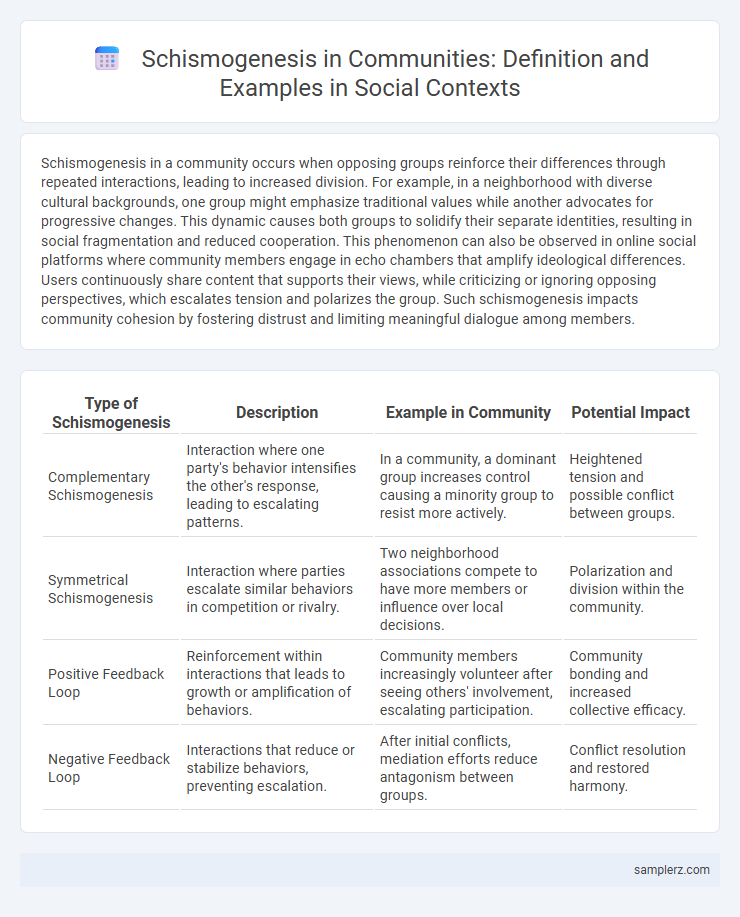Schismogenesis in a community occurs when opposing groups reinforce their differences through repeated interactions, leading to increased division. For example, in a neighborhood with diverse cultural backgrounds, one group might emphasize traditional values while another advocates for progressive changes. This dynamic causes both groups to solidify their separate identities, resulting in social fragmentation and reduced cooperation. This phenomenon can also be observed in online social platforms where community members engage in echo chambers that amplify ideological differences. Users continuously share content that supports their views, while criticizing or ignoring opposing perspectives, which escalates tension and polarizes the group. Such schismogenesis impacts community cohesion by fostering distrust and limiting meaningful dialogue among members.
Table of Comparison
| Type of Schismogenesis | Description | Example in Community | Potential Impact |
|---|---|---|---|
| Complementary Schismogenesis | Interaction where one party's behavior intensifies the other's response, leading to escalating patterns. | In a community, a dominant group increases control causing a minority group to resist more actively. | Heightened tension and possible conflict between groups. |
| Symmetrical Schismogenesis | Interaction where parties escalate similar behaviors in competition or rivalry. | Two neighborhood associations compete to have more members or influence over local decisions. | Polarization and division within the community. |
| Positive Feedback Loop | Reinforcement within interactions that leads to growth or amplification of behaviors. | Community members increasingly volunteer after seeing others' involvement, escalating participation. | Community bonding and increased collective efficacy. |
| Negative Feedback Loop | Interactions that reduce or stabilize behaviors, preventing escalation. | After initial conflicts, mediation efforts reduce antagonism between groups. | Conflict resolution and restored harmony. |
Understanding Schismogenesis: A Social Dynamics Primer
Schismogenesis in communities manifests through reciprocal actions that intensify social divisions, such as rivalry between neighborhood groups competing for resources or status. This dynamic is evident when escalating behaviors--like exclusion or escalation of conflicts--reinforce group identities and deepen polarization. Understanding schismogenesis reveals how mutual reinforcement of social behaviors can fracture communal cohesion, emphasizing the need for interventions promoting dialogue and cooperation.
Historical Examples of Schismogenesis in Communities
The Hatfield-McCoy feud illustrates classic schismogenesis through escalating cycles of hostility between two Appalachian families, resulting in sustained violence and deep community divisions. Another example is the split within the early Mormon Church in the 19th century, where differing interpretations led to the formation of distinct sects such as the LDS Church and the Community of Christ. The partition of India in 1947 underscores large-scale schismogenesis, where religious and ethnic tensions caused widespread communal violence and mass displacement.
Schismogenesis and Neighborhood Rivalries
Schismogenesis in community contexts often manifests through neighborhood rivalries, where groups engage in escalating behaviors that reinforce social divisions. These rivalries foster competitive interactions, such as disputes over territory, resources, or cultural identity, intensifying mutual opposition and weakening social cohesion. Understanding schismogenesis helps address conflict cycles by promoting dialogue and collaborative problem-solving within divided neighborhoods.
Generational Divides: Youth vs. Elders in Community Settings
Generational schismogenesis in community settings manifests through differing values and communication styles between youth and elders, often creating escalating social tensions. Youth prioritize innovation and digital engagement, while elders uphold tradition and face-to-face interactions, leading to divergent social behaviors and expectations. This divide amplifies intergenerational misunderstandings and challenges community cohesion.
Cultural Schismogenesis: Ethnic and Religious Groups
Cultural schismogenesis in communities often emerges when ethnic or religious groups reinforce distinct norms and values, intensifying social divisions. This process manifests through practices such as segregation, exclusive rituals, and divergent narratives that deepen group identity while alienating others. Over time, these escalating cultural differences lead to entrenched conflicts and reduced opportunities for intergroup cooperation or understanding.
Social Media’s Role in Accelerating Community Schisms
Social media platforms intensify schismogenesis within communities by rapidly amplifying polarized content and enabling echo chambers, which deepen divisions and reinforce opposing group identities. Algorithm-driven feeds prioritize emotionally charged and controversial posts, escalating conflicts and reducing opportunities for constructive dialogue. This digital fragmentation accelerates social group polarization, often leading to entrenched in-group/out-group dynamics and community schisms.
Economic Inequality as a Driver of Community Division
Economic inequality fosters schismogenesis by creating distinct social strata within communities, intensifying competition for resources and opportunities. Wealthier groups often consolidate power and influence, marginalizing lower-income populations and perpetuating systemic disparities. This division exacerbates social fragmentation, undermining community cohesion and collective action.
Schismogenesis in Neighborhood Associations and Local Politics
Schismogenesis in neighborhood associations often emerges through competitive dynamics and divergent interests between resident groups, exacerbating polarization and conflict. Local politics intensify these divides as factions compete for influence over community decisions, access to resources, and policy priorities. This cyclical process escalates tensions, undermining collaboration and community cohesion.
Healing and Preventing Schismogenesis: Community Solutions
Community healing and preventing schismogenesis involve fostering inclusive dialogue and collaborative problem-solving to address underlying conflicts before they escalate. Implementing restorative justice practices and promoting shared goals help bridge divides and rebuild trust among conflicting groups. Establishing ongoing community workshops and leadership training encourages empathy and mutual understanding, reducing the risk of future social fragmentation.
Lessons Learned: Case Studies of Reconciliation after Schismogenesis
Case studies of reconciliation after schismogenesis in communities reveal patterns of conflict escalation rooted in reciprocal antagonistic behaviors. Effective interventions often include facilitated dialogue and restorative justice practices that address underlying grievances and promote mutual understanding. These examples highlight the importance of inclusive communication strategies and ongoing community engagement to repair divisions and rebuild social cohesion.

example of schismogenesis in community Infographic
 samplerz.com
samplerz.com